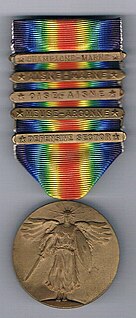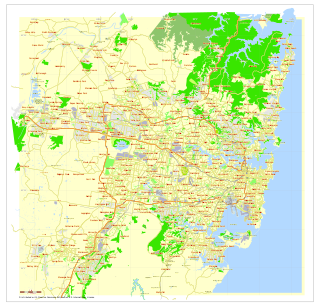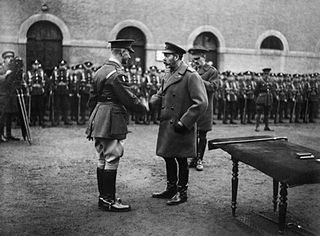
Major General Daniel Marcus William Beak, was a British Army officer and an English recipient of the Victoria Cross, the highest award for gallantry in the face of the enemy that can be awarded to British and Commonwealth forces.

Robert Matthew Beatham, VC was a British-born Australian recipient of the Victoria Cross, the highest award for gallantry "in the face of the enemy" that can be awarded to British and Commonwealth forces. He saw action in the Australian Imperial Force during the First World War and fell at the Battle of Amiens.

Blair Anderson Wark, was an Australian recipient of the Victoria Cross, the highest decoration for gallantry "in the face of the enemy" that can be awarded to members of the British and other Commonwealth armed forces. A quantity surveyor and member of the Citizens Military Force, Wark enlisted in the Australian Imperial Force on 5 August 1915, for service in the First World War. After initially being employed in the defence of the Suez Canal, his battalion was shipped to the Western Front; it was here that Wark would be twice decorated for his bravery and leadership. Having received the Distinguished Service Order in 1917 for his actions at the Battle of Polygon Wood, Wark was awarded the Victoria Cross in 1918 for his leadership and gallantry when in temporary command of his battalion over a three-day period, while conducting operations against the Hindenburg Line.

Lawrence Carthage Weathers, was a New Zealand-born Australian recipient of the Victoria Cross, the highest award for gallantry in battle that can be awarded to a member of the Australian armed forces. His parents returned to their native South Australia when Weathers was seven, and he completed his schooling before obtaining work as an undertaker in Adelaide. He enlisted as a private in the Australian Imperial Force (AIF) in early 1916, and joined the 43rd Battalion. His unit deployed to the Western Front in France and Belgium in late December. After a bout of illness, Weathers returned to his battalion in time to take part in the Battle of Messines in June 1917, during which he was wounded. Evacuated to the United Kingdom, he rejoined his unit in early December.

John Woods Whittle, VC, DCM was an Australian recipient of the Victoria Cross, the highest decoration for gallantry "in the face of the enemy" that can be awarded to members of the British and British Commonwealth armed forces. Whittle was serving as a sergeant in the First World War when he was decorated with the Victoria Cross following two separate actions against German forces during their retreat to the Hindenburg Line in 1917. In the latter action, he attacked a machine gun crew, killing the group and seizing the gun.

James Park Woods, VC was an Australian recipient of the Victoria Cross, the highest award for gallantry in the face of the enemy that can be awarded to British and Commonwealth forces. Woods enlisted in the Australian Imperial Force in September 1916, and after training in Australia and the United Kingdom, joined his unit, the 48th Battalion, in France in September 1917. Along with the rest of his battalion, he participated in the First Battle of Passchendaele the following month. In early 1918, Woods was hospitalised for several months before rejoining his unit in May. He again reported sick in July, and did not return to the 48th Battalion until mid-August.

Edgar Thomas Towner, VC, MC was an Australian recipient of the Victoria Cross, the highest decoration for gallantry "in the face of the enemy" that can be awarded to members of the British and Commonwealth armed forces. A lieutenant in the Australian Imperial Force during the First World War, Towner was awarded the Victoria Cross for his actions on 1 September 1918, during an attack on Mont St. Quentin on the Western Front.
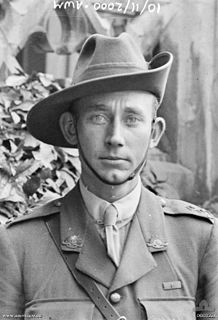
Clifford William King Sadlier, VC was an Australian recipient of the Victoria Cross, the highest award for gallantry in the face of the enemy that can be awarded to British and Commonwealth forces.
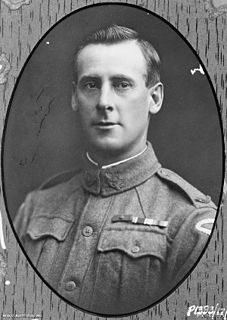
Walter "Wally" Peeler, VC, BEM was an Australian recipient of the Victoria Cross, the highest award for gallantry "in the face of the enemy" that can be awarded to members of the British and Commonwealth armed forces. He was decorated following his actions during the Battle of Broodseinde in October 1917. Then a lance corporal in the Australian Imperial Force, he repeatedly took the lead in the 37th Battalion's advance on well-defended German positions, destroying four machine gun posts and killing more than 30 German soldiers during the battle.

Percy Valentine Storkey, VC was a New Zealand-born Australian recipient of the Victoria Cross (VC), the highest award for gallantry in the face of the enemy that can be awarded to British and Commonwealth forces.

Arthur Charles Hall, VC was an Australian recipient of the Victoria Cross, the highest award for gallantry in the face of the enemy that can be awarded to British and Commonwealth forces. His Victoria Cross was won for his actions in September 1918 on the Western Front during the First World War.

George Morby Ingram, VC, MM was an Australian recipient of the Victoria Cross, the highest decoration for gallantry "in the face of the enemy" that can be awarded to members of the British and Commonwealth armed forces. Ingram became Australia's final recipient of the Victoria Cross during the First World War following his actions during an attack on the village of Montbrehain in France. Leading a platoon during the engagement, he instigated several charges against a number of German strong points that eventuated in the seizure of ten machine guns and sixty-two prisoners, as well as inflicting high casualties.
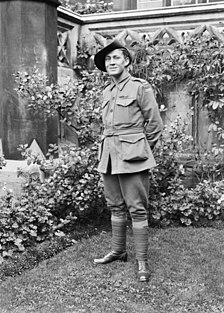
Phillip Davey, was an Australian recipient of the Victoria Cross, the highest award for gallantry in battle that can be awarded to a member of the Australian armed forces. Davey enlisted in the Australian Imperial Force in December 1914, and joined his unit, the 10th Battalion, on the island of Lemnos on 10 April 1915. Along with his battalion, he landed at Anzac Cove, Gallipoli, on 25 April. He fought at Anzac until he was evacuated sick in early November, returning to Australia the following January.
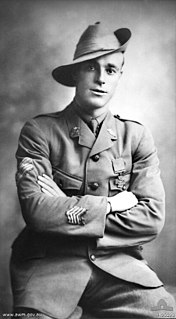
Reginald Roy Inwood, VC was an Australian recipient of the Victoria Cross, the highest award for gallantry in battle that can be awarded to a member of the Australian armed forces. Inwood enlisted in the Australian Imperial Force in August 1914, and along with the rest of the 10th Battalion, he landed at Anzac Cove, Gallipoli on 25 April 1915. He fought at Anzac until being evacuated sick to Egypt in September. He remained there until he rejoined his unit on the Western Front in June 1916. In August, he fought in the Battle of Mouquet Farm.

Albert David "Alby" Lowerson, VC was an Australian recipient of the Victoria Cross, the highest award for gallantry in the face of the enemy that can be awarded to British and Commonwealth forces.

Joseph "Joe" Maxwell, was an Australian recipient of the Victoria Cross, the highest decoration for gallantry "in the face of the enemy" that can be awarded to members of British and Commonwealth armed forces. Often described as Australia's second most decorated soldier of the First World War, he enlisted in the Australian Imperial Force on 8 February 1915, and served at Gallipoli before being transferred to the Western Front. In just over twelve months he was commissioned and decorated four times for his bravery.

Percy Herbert Cherry, VC, MC was an Australian recipient of the Victoria Cross, the highest decoration for gallantry "in the face of the enemy" that can be awarded to members of the British and Commonwealth armed forces. The award was granted posthumously for Cherry's actions during an attack on the French village of Lagnicourt which was strongly defended by German forces.

Herman James Good, VC was a soldier in the Canadian Expeditionary Force during the First World War and a recipient of the Victoria Cross, the highest award for gallantry "in the face of the enemy" that can be awarded to British and Commonwealth forces. Good received the award for his actions during the Battle of Amiens in August 1918, while fighting around Hangard Wood. Good survived the war and returned to Canada. After his discharge from the military in 1919, Good worked in the lumber industry and then later a fish and game warden. He died of a stroke in 1969, at the age of 81.

Clarence Smith Jeffries, VC was an Australian recipient of the Victoria Cross, the highest decoration for gallantry "in the face of the enemy" that can be awarded to members of the British and Commonwealth armed forces. He was posthumously decorated with the Victoria Cross following his actions in the First Battle of Passchendaele during the First World War, in which he led several parties of men in an attack that eventuated in the capture of six machine guns and sixty-five prisoners, before being killed himself by machine gun fire.

Lieutenant Colonel Maurice Wilder-Neligan,, born Maurice Neligan, was an Australian soldier who commanded the South Australian-raised 10th Battalion during the latter stages of World War I. Raised and educated in the United Kingdom, he was briefly a soldier with the Royal Horse Artillery in London, after which he travelled to Australia where he worked in Queensland. He enlisted as a private in the Australian Imperial Force (AIF) on 20 August 1914 at Townsville, under the name Maurice Wilder, giving Auckland, New Zealand, as his place of birth. A sergeant in the 9th Battalion by the time of the Gallipoli landings of April 1915, he was awarded the Distinguished Conduct Medal, the second highest award for acts of gallantry by other ranks. He was quickly commissioned, reaching the rank of temporary captain before the end of the Gallipoli campaign. During his time at Gallipoli he was wounded once, and formally changed his name to Wilder-Neligan.

